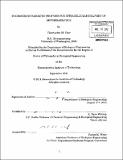Engineering targeted proteins for intracellular delivery of biotherapeutics
Author(s)
Pirie, Christopher M
DownloadFull printable version (19.63Mb)
Other Contributors
Massachusetts Institute of Technology. Dept. of Biological Engineering.
Advisor
K. Dane Wittrup.
Terms of use
Metadata
Show full item recordAbstract
Biotherapeutics have revolutionized medicine with their ability to achieve unprecedented molecular recognition and mediate complex biological responses. The intracellular delivery of biotherapeutics is an unmet scientific challenge and medical need. A wide variety of different treatment modalities depend on not only on the ability to achieve intracellular delivery, but to do so in a targeted manner. An independently-targeted, two-molecule system was developed to accomplish intracellular delivery in a uniquely specific manner. Immunotoxins were designed based on the plant toxin gelonin and targeted towards the canonical cancer-specific antigens: epidermal growth factor receptor and carcinoembryonic antigen. Using quantitative internalization flow cytometry matched with controlled exposure cytotoxicity, the number of internalized gelonin immunotoxins required to induce apoptosis in a single cell was found to be ~5x10⁶ molecules. This threshold to cytotoxicity was conserved across all gelonin constructs regardless of antigen target, binding scaffold, affinity, or cell line. Next, cholesterol-dependent cytolysins were targeted to the same antigens by genetic fusion to engineered fibronectin domains. When combined in vitro, targeted gelonin and cytolysin had synergistic cytotoxic effects and the presence of cytolysin reduced the intracellular barrier to cytotoxicity to < 10⁴ immunotoxin molecules. In vivo, these molecules induced nonspecific, dose-limiting toxicities at varying levels and were cleared from the plasma at rates consistent with their molecular weight. Dosed individually, neither compound was capable of controlling tumor xenografts, but when combined in a delayed dosing scheme they inhibited tumor growth and induced apoptosis throughout xenografts as confirmed by histology. Mathematical modeling was informed by in vivo experiments and provided insight in dosing and tumor exposure overlap. These results emphasize the necessity of a targeted intracellular delivery system and support the merit of the described approach. Additional research into the safety and efficacy of these molecules as well as the design of new constructs will certainly improve the clinical relevance of this technique.
Description
Thesis (Ph. D.)--Massachusetts Institute of Technology, Dept. of Biological Engineering, 2011. Cataloged from PDF version of thesis. Includes bibliographical references.
Date issued
2011Department
Massachusetts Institute of Technology. Department of Biological EngineeringPublisher
Massachusetts Institute of Technology
Keywords
Biological Engineering.